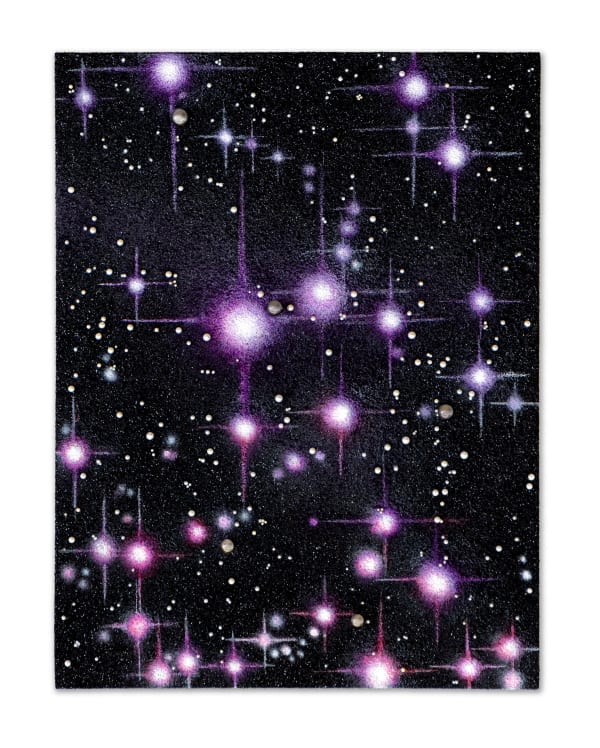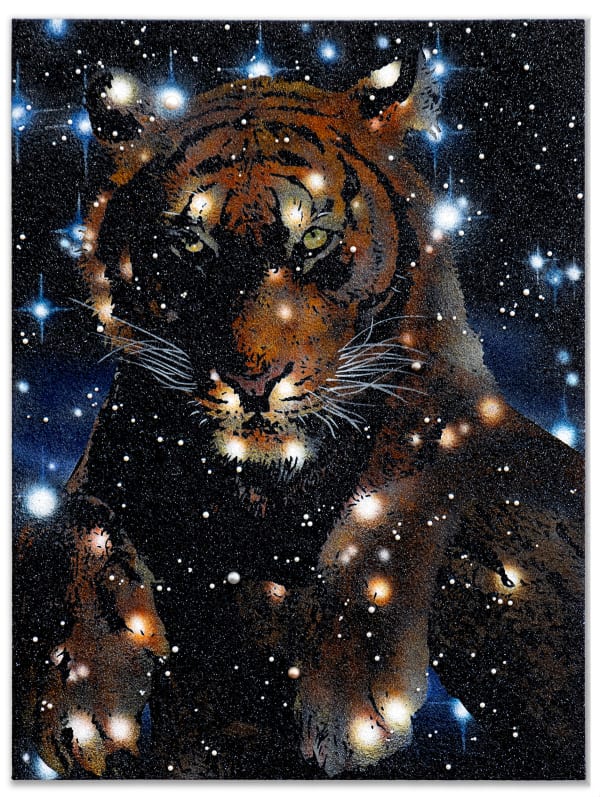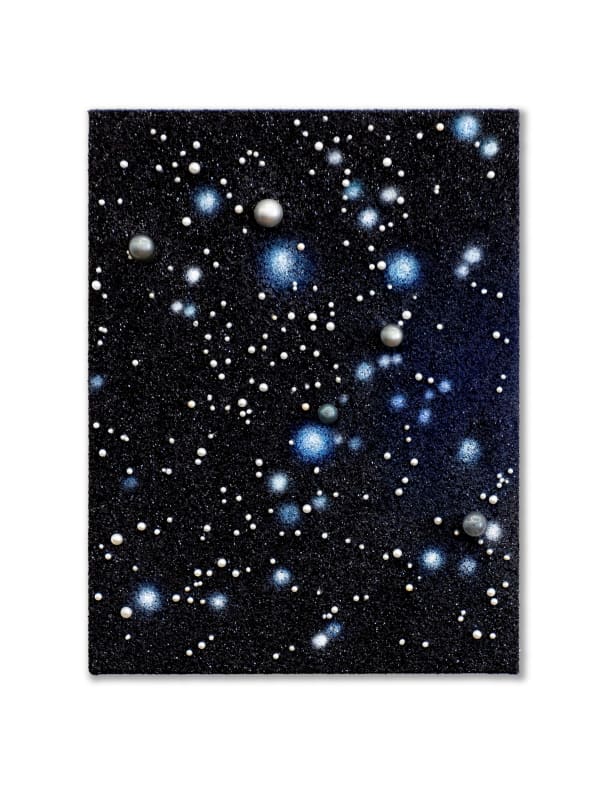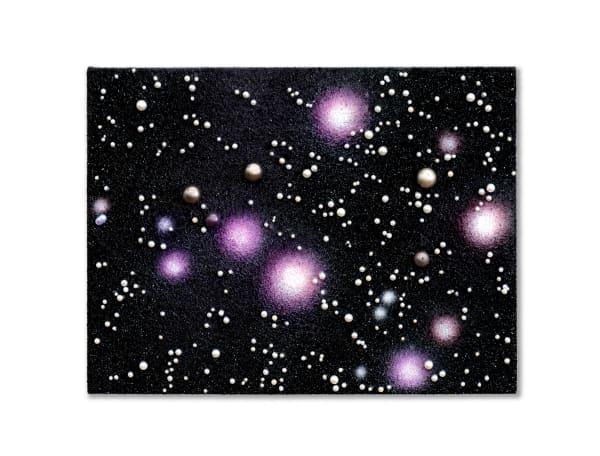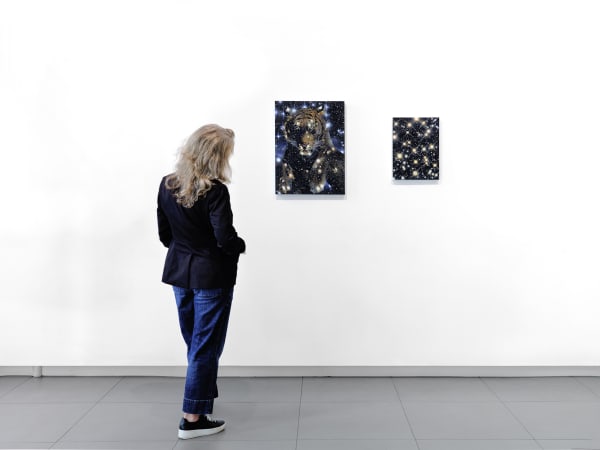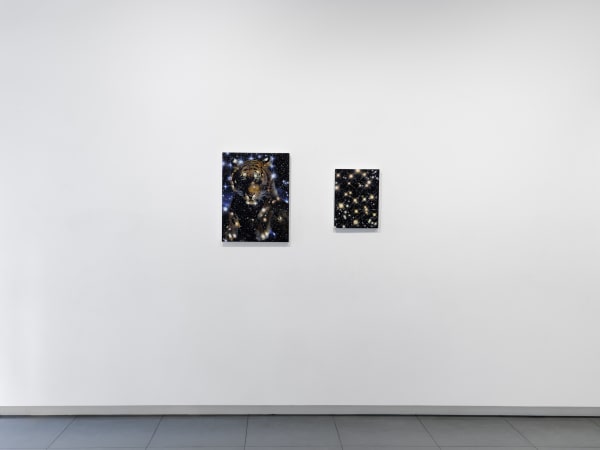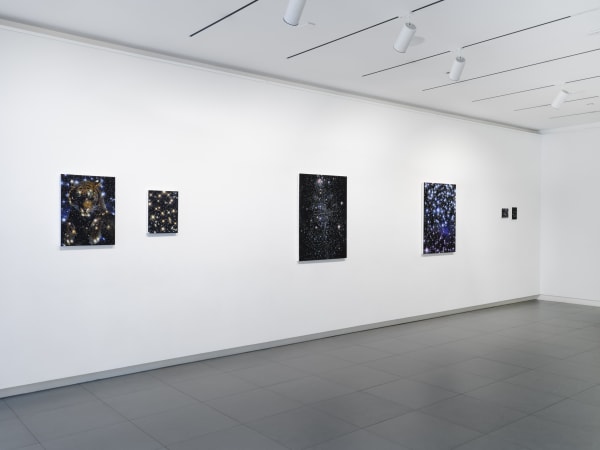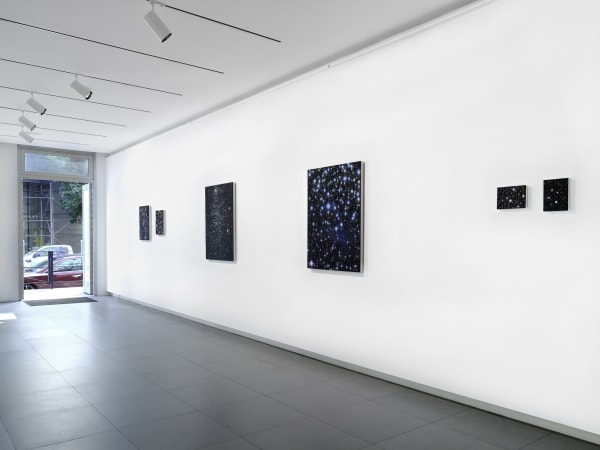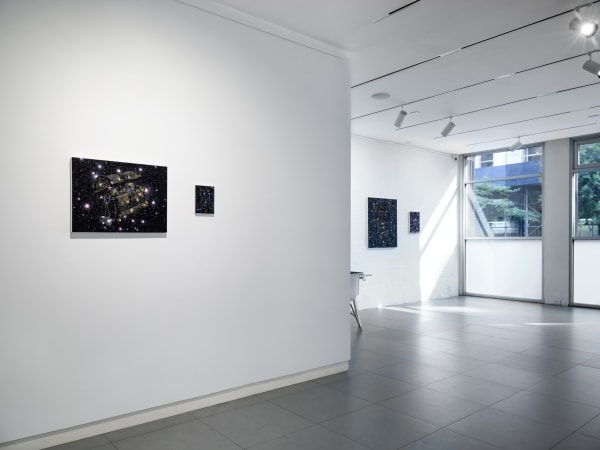In The Stars I Trust: Reuben Paterson
In a city where the stars are often hidden, Paterson’s paintings reveal them, reminding us that the true stars aren’t just in the sky—they’re within us, woven like pearls into our histories, cultures, and connections to the land and one another.
Nearly thirty-five years ago, the Hubble Space Telescope launched from Merritt Island, Florida, and after correcting its flawed optics, provided detailed images that have helped answer longstanding astrophysical questions. Reuben Paterson, an Auckland-born artist of Māori and Scottish descent, responds to these so-called answers with deeper imagination. His series In The Stars I Trust features ten mixed-media paintings based on constellations captured by the Hubble, viewed from a Southern Hemisphere perspective.
Gow Langsford Gallery at Jutta Gallery
104 Charlton St
NY, New York 10014
Monday - Saturday: 10 - 6pm
Sunday: 11 - 5pm
(Open Indigenous People’s Day 14 October)
Opening Reception: Tuesday 8 October, 6 - 8pm
Artist Talk*: Tuesday 8 October, 5.30pm
*Kindly sponsored by Elysian.
-
 Reuben Paterson, The Event to Watch (Constellation Pavo), 2024
Reuben Paterson, The Event to Watch (Constellation Pavo), 2024 -
 Reuben Paterson, Happy Knowing Nothing (Constellation Orion), 2024
Reuben Paterson, Happy Knowing Nothing (Constellation Orion), 2024 -
 Reuben Paterson, Power Bottom (Constellation Pavo), 2024
Reuben Paterson, Power Bottom (Constellation Pavo), 2024 -
 Reuben Paterson, Avoiding Ordinary Boys (Constellation Pavo), 2024
Reuben Paterson, Avoiding Ordinary Boys (Constellation Pavo), 2024 -
 Reuben Paterson, Happy Being No-one But Themselves (Constellation Orion), 2024
Reuben Paterson, Happy Being No-one But Themselves (Constellation Orion), 2024 -
 Reuben Paterson, Keep Your Secrets Here (Constellation Centaurus), 2024
Reuben Paterson, Keep Your Secrets Here (Constellation Centaurus), 2024 -
 Reuben Paterson, As Above so it is Below (Constellation Orion), 2024
Reuben Paterson, As Above so it is Below (Constellation Orion), 2024 -
 Reuben Paterson, Could That Be Me (Constellation Centaurus), 2024
Reuben Paterson, Could That Be Me (Constellation Centaurus), 2024 -
 Reuben Paterson, Earthalujah (Constellation Pavo), 2024
Reuben Paterson, Earthalujah (Constellation Pavo), 2024 -
 Reuben Paterson, Could That Be You (Constellation Southern Cross), 2024
Reuben Paterson, Could That Be You (Constellation Southern Cross), 2024
Text by Daniel Felsenthal
The Hubble Space Telescope launched from Merritt Island, Florida nearly thirty-five years ago. It has, after lengthy corrections on a flawed optical system, beamed down accurate images of the universe, filling holes that have riddled the field of astrophysics for generations. Reuben Paterson (b. 1973) takes these supposed answers as reasons to delve more deeply into the imagination. The ten mixed-media paintings that compose In The Stars I Trust feature constellations, mapped and scaled to correspond with the placement of star patterns captured by HST. We see these formations from the vantage of the Southern Hemisphere, where Paterson was born in Auckland, New Zealand to parents of Māori and Scottish descent. His acrylics of night skies are punctuated by pearls the artist sourced from the Pacific. Such sea-born gems, according to one story told by First Nations people throughout Oceania, are tears that the stars produced when they peered into the darkness of the oceans, to shed a bit of light on an unsympathetic planet.
Paterson’s conceptually rich practice searches for light. He’s known in his birth country, where he’s one of the most lauded artists on the contemporary scene, for his bountiful, unusual use of glitter, a material that shines, sometimes annoyingly so, and generously spreads everywhere—maybe a bit too generously. Glitter is a complicated and labor-intensive substance to incorporate in one’s studio; it’s also campy, ostentatious, industrial, often American-made and overwhelmingly queer-coded. Paterson’s vast, tactile visions of nature can evoke the austere oils of Vija Celmins, yet his sparkly confetti is a flamboyant departure. This art lets itself be gay.
Paterson bejewels a grayscale galaxy, spangles it in his sexuality and takes Māori philosophy as his own, teasing tales from his cultural heritage and threading them through a queer present. Like the stars with their pearls, he uses glitter to illuminate a gloomy world. Figuration appears irreverent in his cosmos partially because of his images’ air of gentleness and goodwill. He redefines the tiger’s role at the top of the food chain with his depiction of a bedroom-eyed beast, its paws seemingly submissive, in Power Bottom (Constellation Pavo). The treasure chest in Happy Being No-one But Themselves (Constellation Orion) suggests that the ultimate prize isn’t wealth, but truth to one’s own desires and beliefs. His rejection of avarice, in a region ravaged by maritime greed, mirrors his pictures’ refusal to obey the edicts of “refined taste.” Both are values that so much of the world has been compelled to inherit from imperial superpowers.
Beneath the playfulness of Paterson’s work—or, perhaps, hundreds of miles above it—floats a sense of unease that feels weightier when one knows that the artist uprooted from New Zealand and moved to Lower Manhattan in 2023. Hubble is a predominantly American invention, and Paterson’s use of its cartography indicates a persistence of colonialism, less visible if perhaps more all-seeing and global than ever. He is forced to view his home, his traditions and his very nighttime through a U.S.-made lens. The notion of homosexuality in its modern form, with its campy touchstones and focus on identity, is a Western export that indigenous people can only map onto their own experiences by way of a careful, conscious balance. Paterson is heir to an intricate notion of self, but he never walks a tightrope. His art prances, peacocks, struts its stuff, and with a heart as open as the Southern Sky, invites us inside.
I may look alone, but there are Angels around me
Essay by Dina Jezdić
The silence of a falling star
Lights up a purple sky
And as I wonder where you are
I'm so lonesome I could cry
Hank Williams
First Nations Māori artist, Reuben Paterson is celebrated for his glittering paintings that seamlessly blend the vibrant, the sacred, and the ancestral. In his latest body of work, he deepens his exploration of celestial navigation, grounding himself in his whakapapa (Māori genealogy) and the land of Aotearoa New Zealand, even as he navigates new horizons far from home. For Māori, "home" transcends mere geography; it represents a profound, enduring bond with the land, rooted in a spiritual relationship with Papatūānuku (Earth Mother) and Ranginui (Sky Father). These celestial connections are reminders of the creation story, where Tāne Mahuta, the god of the forests, adorned the sky with stars, including the sun and moon, placed in three baskets in a canoe. The brightest star, Atutahi (Canopus), was suspended outside the Milky Way, symbolizing the enduring link between the heavens and the earth. This connection, grounded in whakapapa, unites all living things and affirms the permanence of home as both a physical and spiritual anchor.
If home reflects the profound relationship between people and the land, Reuben Paterson invites us to explore this universal concept through the lens of his experiences living in New York City. From an individual or whānau (family) perspective, "home" often signifies a sense of permanence within a human lifetime or across two or three generations. However, when we consider home in the context of hapū (kinship group), iwi (tribe), tipuna (ancestors), or even Hawai’iki (the traditional Māori place of origin), the idea of home extends across vast, almost celestial timeframes, challenging our assumptions about its permanence.
When we view stars through the mournful lens of Hank Williams’ "I’m So Lonesome I Could Cry," a profound sense of isolation emerges. The song vividly captures a solitary cowboy beneath a vast purple sky, his gaze fixed on a lone, falling star. The silence of that star mirrors the cowboy's deep emotions—a haunting symbol of masculinity tinged with sorrow, a feeling that has resonated through generations of Americans. Yet, where the cowboy stands alone, Reuben Paterson is never truly solitary. When Paterson looks up at the night sky, he is surrounded by the presence of his ancestors. The constellations, though hidden from view, burn brightly within him, tethering him to his whakapapa and the celestial guardians who have watched over his people for generations. In this connection, there is no loneliness—only a profound sense of belonging. This contrast between the cowboy’s solitary gaze and Paterson’s ancestral communion reveals a deep truth, where the cosmos is not a silent witness to our isolation but a living connection to those who came before us, guiding us through the darkest nights or across the vastest ocean on Earth.
Paterson draws us into the Māori or cosmos, where multiple concepts of home coexist—including a timeless, dimensionless universe brimming with infinite potential. His latest work takes inspiration from the Southern Hemisphere constellations of Centaurus, Pavo, The Southern Cross and Orion—celestial formations that have guided his ancestors through the Pacific for generations. The constellation Centaurus, linked to Tāwhaki—a legendary figure in Māori mythology who ascended to the heavens to retrieve the sacred baskets of knowledge—mirrors Paterson’s own artistic journey. While Orion is visible in both hemispheres, Paterson’s practice is deeply informed by the way these constellations are embedded in the Māori worldview. In Māori tradition, Orion forms part of the larger celestial canoe known as Te Waka o Rangi, symbolizing the journey of spirits. According to Māori cosmology, this celestial waka collects the spirits of the dead, releasing them after a month into the heavens to become stars. This belief is a poignant reminder that the stars are not just distant suns; they are the spirits of ancestors, watching over the living and guiding them on their journey. The celestial waka, led by Matariki (the Pleiades star cluster), is central to this understanding. Matariki, which rises in the midwinter southern sky, signals the Māori New Year and is a time for remembering those who have passed and celebrating the future - a powerful symbol of the cycle of death and rebirth.
Paterson’s paintings embody this cosmological understanding, using glitter to evoke the luminosity of the stars and the sacred connections they represent. His works are more than visual spectacles; they are spiritual landscapes where the physical and metaphysical converge. The wild cats that emerge in his paintings symbolize queer sexuality, power dynamics, and the exotic, inviting us to question our nature and the drivers of our desires, encouraging an open and courageous departure from normative classifications and traditions. [1]
Mirroring the constellation of Pavo, which embodies beauty, pride, and the sacredness of life. In Māori culture, the eyes of the ancestors are seen as guardians of the living, and Paterson’s use of pearls and the hypnotic nature of wild cats metaphorically represent these watchful eyes. Each particle of glitter becomes a star in the firmament, a point of light connecting the earthly with the divine.
In a city where the stars are often hidden, Paterson’s paintings reveal them, reminding us that the true stars aren’t just in the sky—they’re within us, woven like pearls into our histories, cultures, and connections to the land and one another. His art invites new audiences to look beyond the surface, to see the stories and spirits that shimmer in every corner, and to recognize that the stars, like our ancestors, are always watching, guiding, and protecting us, no matter where we are. Paterson, wears the celestial blanket of his culture like a sparkling cloak, enveloping us all in its radiant embrace.
[1] See https://www.pagegalleries.co.nz/usr/library/documents/main/reuben-paterson_-un-common-relations_dina-jezdic.pdf

